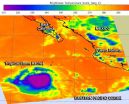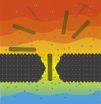(Press-News.org) NASA's Aqua satellite saw the area of strong thunderstorms with colder cloud tops had grown within the Eastern Pacific Ocean's Tropical Storm Rachel.
NASA's Aqua satellite passed over the large Tropical Storm Rachel on Sept. 25 at 4:41 p.m. EDT and the Atmospheric Infrared Sounder or AIRS instrument, saw that the extent of colder cloud tops had increased, indicating thunderstorm heights were increasing and it was strengthening. The expansion of those stronger thunderstorms also suggests that the northeasterly wind shear may be relaxing a little. The strongest thunderstorms remain limited to the southwest of the low-level center,
At 5 a.m. EDT on Sept. 26, the center of Tropical Storm Rachel was located near latitude 18.0 north and longitude 112.9 west. That's about 390 miles (630 km) south-southwest of the southern tip of Baja California, Mexico. Rachel is expected to go through a short period of strengthening before weakening again. Maximum sustained winds remain near 50 mph (85 kph). Some strengthening is forecast through Saturday, Sept. 27, with weakening expected to begin by Saturday night.
Rachel was moving toward the west-northwest near 14 mph (22 kph) and is expected to turn to the north-northwest late on Sept. 27.
The National Hurricane Center forecast calls for an increase in wind shear by Sept. 28 and beyond while Rachel moves over marginally cooler water and into a drier, more stable environment. So, steady weakening is expected to begin by on Sunday, Sept. 28, with the cyclone likely becoming a remnant low early next week.
INFORMATION:
Rob Gutro
NASA's Goddard Space Flight Center
NASA identifies cold cloud tops in Tropical Storm Rachel
2014-09-26
ELSE PRESS RELEASES FROM THIS DATE:
Underwater robot for port security
2014-09-26
Last week, at the International Conference on Intelligent Robots and Systems, MIT researchers unveiled an oval-shaped submersible robot, a little smaller than a football, with a flattened panel on one side that it can slide along an underwater surface to perform ultrasound scans.
Originally designed to look for cracks in nuclear reactors' water tanks, the robot could also inspect ships for the false hulls and propeller shafts that smugglers frequently use to hide contraband. Because of its small size and unique propulsion mechanism — which leaves no visible wake — the ...
Penn team studies nanocrystals by passing them through tiny pores
2014-09-26
An interdisciplinary team of University of Pennsylvania researchers has now applied a cutting-edge technique for rapid gene sequencing toward measuring other nanoscopic structures. By passing nanoscale spheres and rods through a tiny hole in a membrane, the team was able to measure the electrical properties of those structures' surfaces.
Their findings suggest new ways of using this technique, known as "nanopore translocation," to analyze objects at the smallest scale.
The research was led by Marija Drndić, professor in the Department of Physics and Astronomy ...
Geisel researchers contribute to study of trained immunity
2014-09-26
Hanover, NH - A study published in the journal Science provides support for a new—and still controversial—understanding of the immune system. The research was conducted by collaborators in the U.S. and Europe, including Robert Cramer, PhD, an assistant professor of microbiology and immunology at the Geisel School of Medicine and member of the Dartmouth Lung Biology Center, and Kelly Shepherdson, PhD, at the time a graduate student in Cramer's lab.
Typically, scientists divide the immune system into two categories: the innate immune response and the adaptive immune response. ...
New UT Dallas technology may lead to prolonged power in mobile devices
2014-09-26
Researchers from The University of Texas at Dallas have created technology that could be the first step toward wearable computers with self-contained power sources or, more immediately, a smartphone that doesn't die after a few hours of heavy use.
This technology, published online in Nature Communications, taps into the power of a single electron to control energy consumption inside transistors, which are at the core of most modern electronic systems.
Researchers from the Erik Jonsson School of Engineering and Computer Science found that by adding a specific atomic ...
High-throughput cell-sorting method can separate 10 billion bacterial cells in 30 minutes
2014-09-26
University of Hawaii at Manoa College of Engineering mechanical engineer Yi Zuo has developed a new, high-throughput method for sorting cells capable of separating 10 billion bacterial cells in 30 minutes.
The finding has already proven useful for studying bacterial cells and microalgae, and could one day have direct applications for biomedical research and environmental science—basically any field in which a large quantity of microbial samples need to be processed.
The new method was described in a September 2014 publication in the scientific journal Analytical Chemistry, ...
New scientific review of genetically engineered feeds in livestock diets
2014-09-26
An article published in the peer-reviewed Journal of Animal Science concludes feeding livestock diets that contain genetically engineered (GE) crops has no impact on the health or productivity of those animals. In a thorough review of scientific literature and field data sets, the article documents evidence that the performance and health of food-producing animals fed GE crops are comparable with those of animals fed non-GE crops.
Since their introduction in 1996, GE feed crops have become an increasing component of livestock diets. Today, more than 95 percent of U.S. ...
Experts call for widening the debate on climate change
2014-09-26
Environmental scientists are being urged to broaden the advice they give on global climate change, say experts who are also frustrated that decision makers are not taking enough action.
Writing in the journal Nature Climate Change, The University of Manchester researchers argue that scientists are expressing a strong desire to fix the problems highlighted by their studies into human-induced climate change
The authors suggest there are problems with environmental scientists offering practical solutions that can help societies adapt to a fast-changing Earth - one where ...
How plankton gets jet lagged
2014-09-26
A hormone that governs sleep and jet lag in humans may also drive the mass migration of plankton in the ocean, scientists at the European Molecular Biology Laboratory (EMBL) in Heidelberg, Germany, have found. The molecule in question, melatonin, is essential to maintain our daily rhythm, and the European scientists have now discovered that it governs the nightly migration of a plankton species from the surface to deeper waters. The findings, published online today in Cell, indicate that melatonin's role in controlling daily rhythms probably evolved early in the history ...
Green light for clever algae
2014-09-26
The researchers headed by Prof Dr Nicole Frankenberg-Dinkel have been the first ones to reveal similarities and differences in the assembly of the light-harvesting machinery of the cryptophyte Guillardia theta compared to cyanobacteria and red algae. The publication of their results in the current issue of "The Journal of Biological Chemistry" is among the two per cent of the publications that were selected as "Paper of the week".
Cryptophytes: Matryoshka dolls of the waters
Unlike traditional eukaryotic cells – i.e. all cells with a nucleus – cryptophyte cells resemble ...
Skin pigment renders sun's UV radiation harmless using projectiles
2014-09-26
Researchers at Lund University in Sweden and other institutions have worked out how the pigment of the skin manages to protect the body from the sun's dangerous UV rays. The skin pigment converts the UV radiation into heat through a rapid chemical reaction that shoots protons from the molecules of the pigment.
In a new study, the team from Lund University, working with colleagues in France and Italy, have studied pigment in the skin and its building blocks. Pigment in both skin and hair comprises two different types of melanin: eumelanin and pheomelanin. Eumelanin makes ...




